 This is where I’ll be on Tuesday for the POET Project LIBERTY Field Day. The action will take place at their biorefining facility in Emmetsburg, IA starting at 10 a.m.
This is where I’ll be on Tuesday for the POET Project LIBERTY Field Day. The action will take place at their biorefining facility in Emmetsburg, IA starting at 10 a.m.
Agriculture equipment manufacturers will soon put cob harvesting equipment on the market, and Iowa farmers will have a chance to see the latest prototypes in action at Project LIBERTY Field day at POET Biorefining – Emmetsburg (Iowa). Cobs will be the primary feedstock for POET’s commercial cellulosic ethanol plant in Emmetsburg. Also at the event, four-star General Wesley Clark and Iowa Lt. Governor Patty Judge will join POET CEO Jeff Broin in addressing the crowd about cellulosic ethanol and its importance to our energy future.
I hope to have some coverage online here late that morning. Last year it was cold and wet. This year we’re hoping to get a break in the weather so we can see equipment harvest demonstrations in the afternoon.
Wind’s Success is Transmission Lines’ Problem
Wind power out West is booming… and that’s a bit of a problem. No, not a problem because of all of the clean energy the wind is producing. But the aging infrastructure to get that power to the people who can use it is loaded to the max, and this article from UPI says it’s time for an update:
 Future wind projects mean the region’s electrical grid must be expanded, which won’t be without controversy, said Brent Fenty, who heads the Oregon Natural Desert Association, which is tracking transmission proposals.
Future wind projects mean the region’s electrical grid must be expanded, which won’t be without controversy, said Brent Fenty, who heads the Oregon Natural Desert Association, which is tracking transmission proposals.
“There’s no question that we are changing the face of the state right now. And the important part is that we do that in a way that is responsible and reflects our values,” Fenty told The (Portland) Oregonian.
Hundreds more wind turbine projects are planned for Washington, Oregon, Idaho and Montana, most of them on private land. New power lines to carry that energy, however, must be built on public lands and carry a long-term impact, said Erik Fernandez, spokesman for the group Oregon Wild.
“If we do this the wrong way, there’s going to be a large price tag environmentally,” Fernandez said.
So I guess that’s the right kind of problem to have: too much green power. Now, if some upgrades that are in the works, such as the Tres Amigas Super Station in Clovis, New Mexico that aims to link major wind and solar projects with the U.S. population centers (see my post from October 14, 2009), come to fruition, all this bounty of wind power should be a blessing.
WI Biomass Biodiesel Plant to Commission Next Week
A biodiesel plant that will make the green fuel from Wisconsin wood biomass is set for commissioning next week.
This article from Biomass Magazine says the Flambeau River BioFuel LLC’s project will be commissioned using Honeywell Process Solutions’ supplies and automation equipment for what has been called the largest second-generation green diesel plant in the United States. The pilot testing is being done at the Southern Research Institute facility in Durham, N.C.:
“We need to operate [the pilot facility] for 1,000 hours to meet the requirements for a DOE loan guarantee and we need to prove the mass energy balance to make sure we have a project,” [Bob Byrne, president of Flambeau River BioFuels LLC, Park Falls, Wis.] said. “We need to know the economics are there.” An earlier proposal to collocate a cellulosic ethanol plant next to the paper mill at Park Falls was dropped because the economics proved unfavorable as the study progressed. This time, the developers are utilizing gasification and Fischer Tropsch technologies to convert woody biomass into biomass-based diesel and waxes.
The pilot facility at Southern Research Institute will be using Wisconsin wood to fuel a biomass gasifier designed by ThermoChem Recovery International Inc., Baltimore, Md. The syngas produced in the gasifier will be formed into liquids and waxes using catalysts developed by Emerging Fuels Technology, Tulsa, Okla., in a FT reactor. The $257 million plant in the engineering phase for Park Falls will produce 18 MMgy of FT liquids and waxes from 350,000 dry tons of biomass per year, according to Byrne. Depending on the pressures and temperatures of the FT reactor and the activity level of the catalyst, the plant will produce up to 10 MMgy of FT waxes and 8 MMgy FT diesel or 9 MMgy of each. The plant will also be supplying steam to the adjacent paper mill.
Company officials say the wax and steam produced pays the bills, and the biodiesel gives them operating income.
Biofuels Part of Next Farm Foundation Forum
 Mark your calendar for Nov. 10th, as the Farm Foundation sponsors the latest in its free forums that discuss the food, agricultural and rural policy issues facing this country.
Mark your calendar for Nov. 10th, as the Farm Foundation sponsors the latest in its free forums that discuss the food, agricultural and rural policy issues facing this country.
This upcoming discussion, held from 9 a.m. to 11 a.m. at the National Press Club, 529 14th Street NW, Washington D.C., focuses on energy issues, in particular biofuels:
Burton English of the University of Tennessee will discuss projected impacts of proposed federal renewable portfolio standards on the economy of four states-Kansas, Colorado, North Carolina and Florida. This study was done by the Biobased Energy Analysis Group of the Department of Agricultural Economics at the University of Tennessee, and was funded in part by a grant from the Bipartisan Policy Center. English will also discuss methodologies and scenarios used by University of Tennessee researchers in preparing a second study that was funded by 25x’25. Results of that study are scheduled to be released on Wednesday, Nov. 11.
How greenhouse gas (GHG) policies might affect U.S. agriculture is the subject of a third study, to be discussed by Bruce McCarl of Texas A&M University, one of the report’s nine authors. This study indicates “that policies encouraging agricultural and forestry bioenergy and GHG mitigation efforts could stimulate agricultural income significantly, despite higher associated input costs.”
The program will also look at energy inputs on croplands, which include, of course, feedstocks for biofuels.
Make your reservation for the free forum by the close of business, next Friday, Nov. 6th to to Mary Thompson, Farm Foundation Director of Communication by e-mailing her at mary@farmfoundation.org.
Cargill Buys Nebraska Ethanol Assets at Auction
 Agribusiness giant Cargill acquired the rights to the land and grain handling assets of the incomplete Altra Nebraska ethanol facility in Carleton, Nebraska during an auction conducted by Maas Companies this week. Cargill will take possession of the assets effective November 4.
Agribusiness giant Cargill acquired the rights to the land and grain handling assets of the incomplete Altra Nebraska ethanol facility in Carleton, Nebraska during an auction conducted by Maas Companies this week. Cargill will take possession of the assets effective November 4.
Construction on the Altra facility began in 2006 and was approximately half complete in November 2007 when work stopped after its owners were unable to secure additional financing.
The facility is located near the existing Cargill AgHorizons grain handling facility and regional Farm Service Group leader Robert Racek says the new asset will complement Cargill’s existing grain handling capabilities. “This facility is a valuable asset to the entire region, and we intend to invest further in optimizing its value for our producer customers,” said Racek. “While we will have to make additional enhancements to the facility to make it fully operational, we are determined to leverage this opportunity to offer more flexibility to area crop producers in terms of the delivery, storage, handling and marketing of their grain.”
Cargill AgHorizons’s regional Aksarben farm service group also operates grain handling facilities in Albion, Lincoln, O’Neil, and Ord, Neb., as well as Council Bluffs, Iowa.
 Coming up in November, the Minnesota-based Maas Companies will be conducting an auction of 60 million gallons worth of biodiesel-producing equipment at a location in New Jersey. The Greenline Industries equipment is currently in storage and is based on the technology developed and operating in Germany.
Coming up in November, the Minnesota-based Maas Companies will be conducting an auction of 60 million gallons worth of biodiesel-producing equipment at a location in New Jersey. The Greenline Industries equipment is currently in storage and is based on the technology developed and operating in Germany.
NASCAR Eyes Biofuels
 While NASCAR has been greening up its image in the past few years with solar farms, carbon offsets and even keeping its big rigs from unnecessary idling, it still is behind some other major racing leagues that have put green fuels, such as ethanol, into their tanks.
While NASCAR has been greening up its image in the past few years with solar farms, carbon offsets and even keeping its big rigs from unnecessary idling, it still is behind some other major racing leagues that have put green fuels, such as ethanol, into their tanks.
But this article from USA Today says that could be changing:
The concept might seem incongruous in a sport inherently tied to an internal combustion engine that many find synonymous with global warming, but NASCAR, despite cars with an eye-popping 5 mpg, is trying to embrace its eco-conscious side as the federal government has begun prodding the racing industry to become leaders in efficiency…
On the competition side, NASCAR is exploring the replacement of its carburetors with more efficient fuel injection (perhaps as early as 2011) and the use of alternative fuels in at least one of its national series…
The Department of Energy has met with NASCAR officials, and an official says the government wants racing to help develop technology that’s less polluting…
A greener Sprint Cup Series also seems likely to be embraced by its four manufacturers with federal standards for fuel efficiency expected to rise by 10 mpg by 2016. General Motors, Ford, Toyota and Dodge all are producing hybrid vehicles.
“Every company in the world is looking at hybrids, diesels and plug-in vehicles,” says Lee White, president of Toyota Racing Development. “We’d be very interested in (NASCAR) formulating a green look. It makes the sport more relevant to where the business of selling automobiles is being driven.”
Now, for you NASCAR fans who are worried you’ll have to watch electric golf carts race around the track at just faster than a brisk walk, rest easy that the whoosh of rumbling cars going by won’t be eliminated… but maybe some of the choking exhaust will.
Congress, Don’t Forget About Algae Biodiesel
 As the folks who are making the next generation of ethanol made their pitch to Congress (see Cindy’s post from earlier), the people who are producing biodiesel from what could be the next great feedstock, algae, reminded members of the U.S. House Agriculture Committee’s Subcommittee on Conservation, Credit, Energy, and Research not to forget about their truly green fuel.
As the folks who are making the next generation of ethanol made their pitch to Congress (see Cindy’s post from earlier), the people who are producing biodiesel from what could be the next great feedstock, algae, reminded members of the U.S. House Agriculture Committee’s Subcommittee on Conservation, Credit, Energy, and Research not to forget about their truly green fuel.
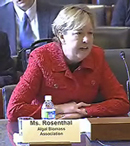 Mary Rosenthal with the Algal Biomass Association told the representatives that despite some good progress for the algae biodiesel industry in recent years (not to mention the potential it holds), many of today’s federal biofuel policies simply ignore the role algae could play, limiting opportunities for funding and regulatory acceptance. She says she just wants a fair shake from the government:
Mary Rosenthal with the Algal Biomass Association told the representatives that despite some good progress for the algae biodiesel industry in recent years (not to mention the potential it holds), many of today’s federal biofuel policies simply ignore the role algae could play, limiting opportunities for funding and regulatory acceptance. She says she just wants a fair shake from the government:
Key to algae’s success in the fuels market will be ensuring:
1. Financial parity – Algae should receive the same tax incentives, subsidies and other financial benefits that other renewable fuels, particularly cellulosic biofuels, receive.
2. RFS parity – Algae is currently excluded from the majority of the Renewable Fuel Standard, due to a 16 billion gallon carve out for cellulosic biofuels. The carve out should be changed so that it is technology neutral, thus allowing algae-based and other environmentally sustainable fuels to contribute to our nation’s efforts to become energy independent.
3. Beneficial CO2 reuse recognition– Algae’s unique ability to turn CO2 into renewable fuels will allow the organism to play a significant role in abating carbon emitted by industrial sources. Consequently, algae’s beneficial reuse of CO2 should be acknowledged and accounted for in carbon capture and sequestration legislation.
Rosenthal urged Congress not to miss the opportunity of developing a truly renewable, sustainable fuel that will create jobs, reduce pollution and increase national energy independence.
Biodiesel Maker Tapped as Economic Champion
 New York-based biodiesel maker and distributor Innovation Fuels has been recognized as an economic champion during the the annual Syracuse Economic Champions luncheon and awards ceremony.
New York-based biodiesel maker and distributor Innovation Fuels has been recognized as an economic champion during the the annual Syracuse Economic Champions luncheon and awards ceremony.
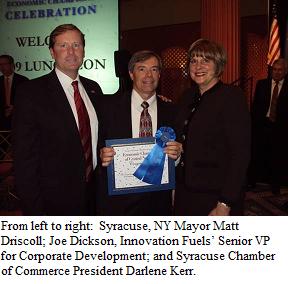 “We are absolutely delighted to be recognized by the local business community and the chamber here in Syracuse,” commented [Joe Dickson, Innovation Fuels’ Senior VP for Corporate Development]. “We are also very pleased to be contributing to the economy in central New York and look forward to future growth in the region.”
“We are absolutely delighted to be recognized by the local business community and the chamber here in Syracuse,” commented [Joe Dickson, Innovation Fuels’ Senior VP for Corporate Development]. “We are also very pleased to be contributing to the economy in central New York and look forward to future growth in the region.”
In part, Innovation Fuels was recognized for relocating its corporate headquarters to downtown Syracuse this past June.
Cellulosic Ethanol Firms Testify Before House Panel
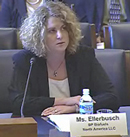 Leading industries in the race to commercialize next generation biofuels told a House agriculture subcommittee hearing on Thursday that more funding and stable government policy are needed to do the job.
Leading industries in the race to commercialize next generation biofuels told a House agriculture subcommittee hearing on Thursday that more funding and stable government policy are needed to do the job.
“The current financial crisis has prevented venture capitalists and bankers from investing in many worthwhile investments,” BP Biofuels North America president Susan Ellerbusch testified. “The industry and investors must see a secure market,” which she said, includes addressing the current 10 percent ethanol blend wall.
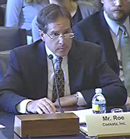 In addition to addressing the blend wall, Coskata president William Roe, whose company is pioneering low-cost production of ethanol from a variety of feedstocks, stressed the need for a consistent and inclusive biomass definition, as well as new or extended tax incentives. “Extend the cellulosic producer tax credit,” he suggested. “This expires in January of 2012 and consequently would provide little or no impact to even the earliest industry movers.” He also recommended flexibility in the monetization of biofuels tax credits.
In addition to addressing the blend wall, Coskata president William Roe, whose company is pioneering low-cost production of ethanol from a variety of feedstocks, stressed the need for a consistent and inclusive biomass definition, as well as new or extended tax incentives. “Extend the cellulosic producer tax credit,” he suggested. “This expires in January of 2012 and consequently would provide little or no impact to even the earliest industry movers.” He also recommended flexibility in the monetization of biofuels tax credits.
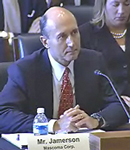 Bruce Jamerson with Mascoma talked about shortcomings in the USDA loan guarantee program that should be addressed. “For example, as the project size increases, the loan guarantee amount reduces which discourages larger projects,” Jamerson said. His company found that the vast majority of commercial lenders are unwilling to work with the loan guarantee program because of its requirements.
Bruce Jamerson with Mascoma talked about shortcomings in the USDA loan guarantee program that should be addressed. “For example, as the project size increases, the loan guarantee amount reduces which discourages larger projects,” Jamerson said. His company found that the vast majority of commercial lenders are unwilling to work with the loan guarantee program because of its requirements.
 The president of Osage Bio Energy, Craig Shealy, told the panel that existing federal loan guarantee programs are “either too restrictive or too structured around specifically technologies, excluding commercial scale biorefineries from eligibility.” He recommended revising those programs, as well as taking other policy steps, such as increasing the ethanol blend level to 15 percent and simplifying the RFS2.
The president of Osage Bio Energy, Craig Shealy, told the panel that existing federal loan guarantee programs are “either too restrictive or too structured around specifically technologies, excluding commercial scale biorefineries from eligibility.” He recommended revising those programs, as well as taking other policy steps, such as increasing the ethanol blend level to 15 percent and simplifying the RFS2.
 Also testifying on the panel was Mary Rosenthal with the Algal Biomass Association, who called for greater recognition of the potential for algae-based fuels. “Algae should receive the same tax incentives, subsidies and other financial benefits allowed to other renewable fuels such as cellulosic ethanol,” she said.
Also testifying on the panel was Mary Rosenthal with the Algal Biomass Association, who called for greater recognition of the potential for algae-based fuels. “Algae should receive the same tax incentives, subsidies and other financial benefits allowed to other renewable fuels such as cellulosic ethanol,” she said.
Opening statements from all panelists are available on the House Agriculture Committee website.
Celebration of 200th E85 Station in Illinois
 As reported from the American Lung Association of Illinois, Governor Pat Quinn joined with corn growers, business leaders and representatives of the American Lung Association in Illinois to celebrate the state’s 200th E85 station at the Green Mount Motomart in Shiloh.
As reported from the American Lung Association of Illinois, Governor Pat Quinn joined with corn growers, business leaders and representatives of the American Lung Association in Illinois to celebrate the state’s 200th E85 station at the Green Mount Motomart in Shiloh.
“It’s vitally important that we continue to bring E85 stations to all parts of Illinois,” said Governor Quinn. “E85 saves money when you fill up your tank, supports Illinois agriculture and jobs, and keeps our air clean.”
Across the country there are more than eight million flex-fuel vehicles on the road today, including more than 300,000 registered in Illinois. These vehicles emit on average 40 percent fewer greenhouse gases annually. Illinois is also one of the largest producers of ethanol in the country. In 2008 more than 500 million bushels of Illinois corn were used to make 1.4 billion gallons of biofuel.
The 200th E85 fueling facility in Illinios is located at 1790 Frank Scott Parkway East in Shiloh. For a listing of E85 facilities, go click here.

